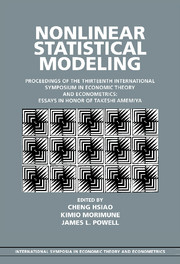 Nonlinear Statistical Modeling
Nonlinear Statistical Modeling Book contents
- Frontmatter
- Contents
- Series editor's introduction
- Editors' introduction
- Contributors
- 1 Local instrumental variables
- 2 Empirically relevant power comparisons for limited-dependent-variable models
- 3 Simulation estimation of polychotomous-choice sample selection models
- 4 A new approach to the attrition problem in longitudinal studies
- 5 Semiparametric estimation for left-censored duration models
- 6 Semiparametric estimation of censored selection models
- 7 Studentization in Edgeworth expansions for estimates of semiparametric index models
- 8 Nonparametric identification under response-based sampling
- 9 On selecting regression variables to maximize their significance
- 10 Using information on the moments of disturbances to increase the efficiency of estimation
- 11 Minimal conditions for weak convergence of the sample standardized spectral distribution function
- 12 Unit root tests for time series with a structural break when the break point is known
- 13 Power comparisons of the discontinuous trend unit root tests
- 14 On the simultaneous switching autoregressive model
- 15 Some econometrics of scarring
- 16 A censored switching regression approach to evaluating the effect of sunk costs and firm-level disequilibrium on export performance
- Curriculum vitae of Takeshi Amemiya
- Index
2 - Empirically relevant power comparisons for limited-dependent-variable models
Published online by Cambridge University Press: 05 June 2012
- Frontmatter
- Contents
- Series editor's introduction
- Editors' introduction
- Contributors
- 1 Local instrumental variables
- 2 Empirically relevant power comparisons for limited-dependent-variable models
- 3 Simulation estimation of polychotomous-choice sample selection models
- 4 A new approach to the attrition problem in longitudinal studies
- 5 Semiparametric estimation for left-censored duration models
- 6 Semiparametric estimation of censored selection models
- 7 Studentization in Edgeworth expansions for estimates of semiparametric index models
- 8 Nonparametric identification under response-based sampling
- 9 On selecting regression variables to maximize their significance
- 10 Using information on the moments of disturbances to increase the efficiency of estimation
- 11 Minimal conditions for weak convergence of the sample standardized spectral distribution function
- 12 Unit root tests for time series with a structural break when the break point is known
- 13 Power comparisons of the discontinuous trend unit root tests
- 14 On the simultaneous switching autoregressive model
- 15 Some econometrics of scarring
- 16 A censored switching regression approach to evaluating the effect of sunk costs and firm-level disequilibrium on export performance
- Curriculum vitae of Takeshi Amemiya
- Index
Summary
Introduction
Most hypotheses in limited dependent variable (LDV) models are composite, meaning that the null hypothesis H0 does not completely specify the datagenerating process (DGP). In this case, the null specifies only that the DGP belongs to a given set. As a consequence, the sampling distribution of a test statistic under H0 is unknown except in special cases, because it depends on the true DGP in the set specified by H0. The problem is how to test the null hypothesis in this situation. In this chapter, the bootstrap is used to solve the hypothesis-testing problem.
The LDV models considered in this chapter are the simple binary probit model and the simple censored normal linear regression model. For these models, a typical null hypothesis H0 is that the slope coefficient is zero. This null is composite, the remaining parameters being nuisance parameters. This null is tested using the Lagrange multiplier (LM), likelihood ratio (LR), and Wald test statistics. In our Monte Carlo experiments, we compare the powers of the competing tests when the tests use bootstrap-based critical values. We argue that the powers of the tests with bootstrap-based critical values are empirically relevant because these critical values can be calculated in applications.
There are two basic approaches to obtaining critical values for testing a composite null hypothesis. One approach employs the concept of the size of a test. The size is the supremum of the test's rejection probability over all DGPs contained in H0.
- Type
- Chapter
- Information
- Nonlinear Statistical ModelingProceedings of the Thirteenth International Symposium in Economic Theory and Econometrics: Essays in Honor of Takeshi Amemiya, pp. 47 - 70Publisher: Cambridge University PressPrint publication year: 2001


